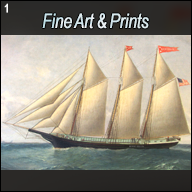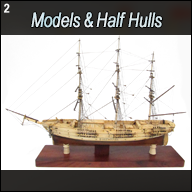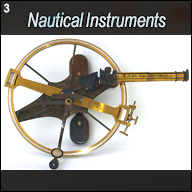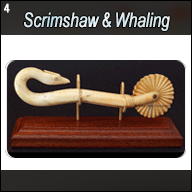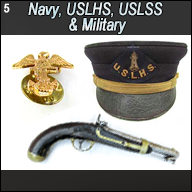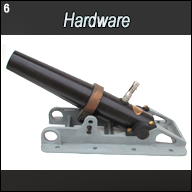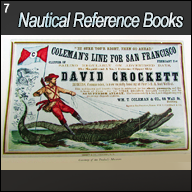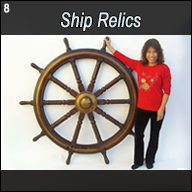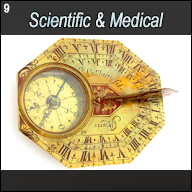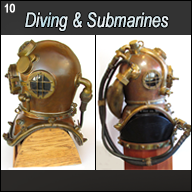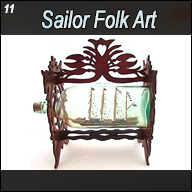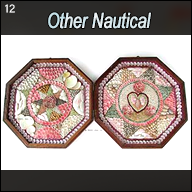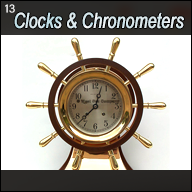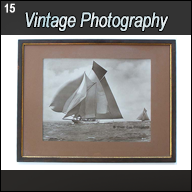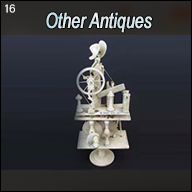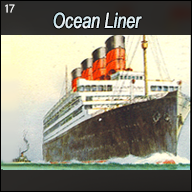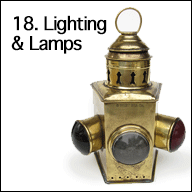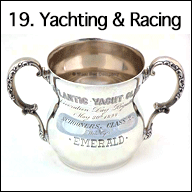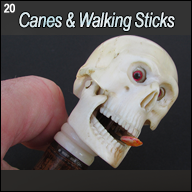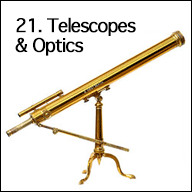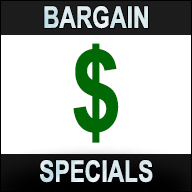New This Week:
Prices in U.S. Dollars are listed in GREEN.
 |
|
3.47 CLASSIC TAFFRAIL LOG. The ultimate in 19th century American taffrail logs as designed, patented and manufactured by John Bliss & Company in the late 1800’s. This pristine example has a hard-fired porcelain register signed “JOHN BLISS & CO. TAFFRAIL LOG PATENTED.” The first of 4 dates is 1875 and the last is “July 21, 1885.” This heavy solid brass log has a cylindrical body with a U-shaped bracket for attachment to the ship. The working end consists of a rotating shaft connected with internal gearing and exiting with a brass hook for attachment to the line carrying the fish (spinner). The attachment is made with period cotton line connecting to the 4-finned brass spinner which is marked “JOHN BLISS & Co.” on one of the blades. Excellent original condition showing actual use. The log assembly measures 13 1/2 inches long overall from the eyelet attachment to the ship to the bottom of the brass hook attaching the line. The body of the log is 2 inches in diameter, not counting the suspension bracket which is 2 3/8 inches wide. The fish (spinner) is 9 ½ inches long and 4 inches wide. Several feet of the original cotton line remain. 395 |
 |
 |
| register | fish |
 |
 |
| attachment | fish maker |
 |
| maker |
 |
|
19.38 YACHT WEATHER STATION. Absolutely charming turn-of-the-century weather station of pre-War German manufacture. This diminutive set is of the highest quality. It features 3 instruments: barometer, thermometer and hygrometer. The barometer has a multi-color hard-fired porcelain dial calibrated in inches of atmospheric pressure from 27.5 to 31.5 in 2/100th increments marked by 10ths. Whole inches, 28 through 31, are identified. The dial bears the standard weather indications “Stormy RAIN Change Fair and Very Dry.” The bottom of the dial is marked “Germany.” A fine blued steel indicator needle points to the reading. It is overlaid by the brass set needle rove through the beveled glass crystal to a knurled brass knob. The brass barometer body is attached to the mount with 3 screws. At the center is the delicate mercury thermometer mounted to its milkglass scale reading in degrees Centigrade and Fahrenheit. The centigrade scale runs from - 8 to 46 and the Fahrenheit scale from 26 to 114. The hair hygrometer reads from “0 Dry” to “100% Moist.” The brass body is protected by the beveled glass crystal. All three instruments are mounted to the rich mahogany oval backboard. It has 2 brass hanging brackets for mounting and measures 8 by 4 ¾ inches. Outstanding original condition in all respects. All functions are guaranteed to be working and accurate. This is the first such instrument of this quality we have had the pleasure of offering in our 40+ years. 485 |
 |
 |
| HYGROMETER | barometer |
 |
| back |
 |
|
18.52 RARE “BIRD CAGE” LAMP. Genuine second half 19th century American small craft anchor lamp made in this distinctive style with 6 brass wire ribs protecting the Freznel glass lens. While unmarked, the maker is definitely American in form and construction. Entirely hand-made, this all brass lamp was beautifully designed and produced. It has a classic 360o Freznel glass lens created to maximize and focus the burner’s lumen output onto the horizon. The “bird cage” struts protect the all important lens while attaching the upper and lower portions of the lamp together. They also serve to separate the suspension loop from the top of the hot chimney when in use. The original oil burner on the font is marked “WEDGE.” The font secures into the bottom of the lamp with a bayonet twist. 11 3/4 inches tall by 4 3/4 inches in diameter. Excellent original condition showing actual use at sea. A very scarce example of this form of marine lantern, particularly prized by collectors. Easily a $750 value. Priced to sell! 495 |
 |
 |
| interior | burner |
 |
| back |
 |
|
22.61 IDENTIFIED SHIP’s BAROMETER/THERMOMETER. Truly exceptional 19th century ship’s barometer/thermometer of large size. Indicative of its Victorian origins, this impressive instrument has a very ornate silvered brass dial with a deeply engraved barometric scale reading from 27.8 to 31.2 inches of atmospheric pressure, calibrated in 2/100th increments marked by 10ths. Whole inches are identified, as are the standard weather indications “Stormy RAIN Change FAIR and Very Dry” in fancy script. The lower half of the dial bears a very large curved mercury thermometer reading in single degrees Fahrenheit from 5 to 115 marked by 10s. The center of the dial is beautifully hand-engraved in a starburst, snow flake pattern of amazing complexity and detail. Seeing is believing under magnification. The top of the dial bears the registered serial number “50992.” The barometric reading is indicated by an incredibly fine blued steel indicator needle which is overlaid by a similar very delicate brass set needle attached to a knurled knob. The knob is rove through the thick beveled glass crystal set in the heavy brass bezel with silvered reflector ring. The stout, solid brass case is of classic British form with a broad mounting flange 8 inches in diameter. The center back of the case is stamped with the maker’s mark “T.A.R.S. & W. LONDON” and matching serial number “50992” stamped above. Etched into the back is the identifier “CHART RM PATEENA.” The barometer dial is 6 inches in diameter and the case is 3 ¾ inches deep. Outstanding original condition. Both the barometer and thermometer functions are very precise and accurate. This is the finest of perhaps 3 identified ship barometers which we have handled in our 40+ years. Absolutely a museum piece of the first order! 1095 The S.S. PATEENA was a passenger/cargo vessel of 1212 gross tons built on the Clyde in Glasgow, Scotland for the Tasmanian Steam Navigation Company in 1883. She was noted for her trim lines and graceful appearance. In 1891 she was purchased by the Union Steamship Company for use in the inter-island ferry service out of New South Wales, Australia. After nearly 30 years of open ocean sailing, she was laid up in 1920, then broken up in 1924. |
 |
 |
| perspective | dial |
 |
 |
| back | identification |
| ship |
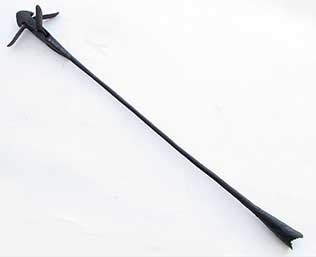 |
4.02 HARPOON. Rare, first half of the 1800's American whaling harpoon. This very scarce example known as a "swivel barb" harpoon, has a complex construction employing 4 folding toggles and an arrowhead tip. Only one type of this early iron is held in the prestigious collection of the New Bedford Whaling Museum. This singularly important example measures 30 inches long by 1 1/2 inches wide at the head with the flukes closed and 6 inches across when extended. It is in original, well used condition with some loses to the cone as expected from countless years in a marine environment. Offered here at an amazing price! SOLD A nearly identical harpoon is depicted on page 208 of Thomas Lytle's book "Harpoons and Other Whalecraft," 1984, The Old Dartmouth Historical Association, New Bedford, Massachusetts. The caption reads, "Four swivel barbs, each 4 inches long, behind small two-flued head. Length 36 inches." |
 |
 |
DETAIL |
SEAM |
 |
 |
CONE |
CLOSED |

|
4.81 /11.64 SAILOR's SCRIMSHAW BLACKJACK. Very rare early 1800's going ashore weapon made and used by an American sailor for his personal protection. Known by a variety of terms including "cosh, cudgel, trunchyeon and bludgeon" this very handsome rope-laid device has two "working ends" consisting of lead-weighted knobs meticulously macraméd in tight Spanish hitching on each end of the surprisingly flexible whale baleen shaft! 12 ½ inches long by 1 ¼ inches thick on the knobs and the baleen shaft is ½ inch thick. A great sailor-made object with a huge amount of intrigue behind it! Price Request Not available or for sale in California. Shipped from Massachusetts from Massachusetts. |
BALEEN |

|
|
AUTHENTIC LIGHTHOUSE. This is the ultimate! Here is an exceptional opportunity to own a very historic relic of America’s rich maritime heritage embodied in the original lamp room from the famous Ballast Point Lighthouse, which served its sentinel duties in the channel of San Diego Bay from 1890 until 1960. This incredibly well-preserved piece of history was built according to specifications laid out by the U.S. Lighthouse Service in 1885. A copy of the original specifications are included as are much printed references and photographs. Erected in 1890, the 5th Order lighthouse was a significant aid to navigation in conjunction with the Point Loma Lighthouse (1850) poised at the entrance to San Diego Bay. Ballast Point Light was situated further inside the massive bay on a point which jutted into the seaway which posed a hazard to shipping. 13 feet 10 inches high with a maximum width of 8 feet 8 inches. Weight approximately 5 tons. It will require a crane and a flat bed truck for transport. 129 years old! Price Request HISTORY On October 2, 1888, recognizing the need for a harbor light in the increasingly congested channel of San Diego Bay, Congress authorized $25,000 for the construction of a lighthouse to be built on Ballast Point. Fashioned in the late Victorian style, the entire structure took 3 months to build beginning in March 1890. The light was first lit on August 1st. It was a sister of the lights at San Luis Obispo and Table Bluff, south of Humboldt Bay. All were wood framed structures with attached living quarters. The ironwork for the lantern was forged in San Francisco and carried south to San Diego by ship. The French firm of Sautter, Lemmonier, & Cie. manufactured the Freznel lens for the Ballast Point Light in 1886. The fixed 5th Order lens was visible for a distance of at least 11 miles. When California was still part of Mexico the peninsula jutting into San Diego Bay was known as Punta del los Guijarros or “Pebble Point.” For centuries cobblestones washed down by the San Diego River had been deposited on the point. When California gained statehood in 1850 the point was renamed Middle Ground Shoal. As time went on and merchant traffic in the harbor increased, many sailing ships found it convenient to load or discharge the stones as ballast. The practice continued and eventually the name “Ballast Point” stuck. Accompanying the Ballast Point lighthouse was a huge 2,000 pound fog bell in a wooden tower. In 1928 it was supplanted by a single tone electric diaphone horn. The first keeper of the light was John M. Nilsson, assigned duty on July 15, 1890. The second was Henry Hall, who took the job on December 1, 1892. Perhaps the most famous keeper was Irish born David R. Splaine, a Civil War veteran and veteran lighthouse keeper, who assumed the post in 1894, having served at Point Conception, the Farallons and San Diego’s own Point Loma light from 1886-1889. In 1913 the original old kerosene lamp was replaced with an acetylene burner. Acetylene gave way to electricity in 1928. In 1938 a filter was fitted inside the 5th Order Freznel lens giving the light a distinctive green hue for recognition. One of the last keepers of the light was Radford Franke who recalled receiving the order to “douse the light” upon the news of the attack on Pearl Harbor. By early 1960 the light was deemed to be of no further service, so in June of that year the lantern room was removed to a salvage yard. The wooden tower and its brick and mortar foundation remained a couple of years later until they too were declared structurally unsafe and demolished. The bell tower continued to survive, mounted with a 375 mm high intensity lamp on its roof. However the value of maintaining any light on Ballast Point diminished with the installation of harbor entrance range lights. In the late 1960’s the bell and its tower were dismantled. The tower found its way to a private residence in Lakeside, California. The bell had a more circuitous later life. It was purchased from a San Diego area junk yard in 1969 for its scrap value of 5 cents per pound! The one ton bell remained on local private property until 1991, when it was put on loan to the San Diego Maritime Museum. In 1999 the bell was transported to the son of the original buyer, living in Colorado. Then in 2002, the bell finally found its way to the home of the owner’s granddaughter living in Vermont, where it rests to this day. The story of the lantern’s later life is even more fascinating. The nation was just recovering from the Cuban Missile Crisis between JFK and Khrushchev, when in 1964 the Cuban government cut off the fresh water supply to the U.S. Naval base at Guantanamo Bay. By that time, an experimental desalinization plant had been in operation at Point Loma for 2 years. The Navy hastily ordered it to be disassembled and shipped through the Panama Canal to Cuba. A gentleman working as a crane operator during the process noted the shabby lantern room in a trash heap nearby. He inquired as to the fate of the relic and was told it was salvage. Asking if he could purchase it, the yard foreman told him he could “have it” if he would haul it away. With that, for the next 34 years the lantern room served as a gazebo in the backyard of the man’s residence in Bonita, California. It was purchased by the present owners in 1998, fully refurbished, and then placed on public display ever since. Now it is time for it to find its next new home. According to the crane operator who delivered the lamp room it weighs approximately 5 tons. It will require a crane and a flat bed truck for removal. BIBLIOGRAPHY F. Ross Holland, “The Old Point Loma Lighthouse,” 1978, Cabrillo Historical Association, San Diego, California Jim Gibbs, “The Twilight of Lighthouses,” 1996, Schiffer Publishing, Atglen, PA. Kin Fahlen and Karen Scanlon, “Lighthouse of San Diego,” 2008, Arcadia Publishing, San Francisco Kraig Anderson, “Forgotten Ballast Point “Lighthouse” Seeks New Home,” article in “Lighthouse Digest,” East Machias, Maine, September – October 2011, Vol. XX, no. 5 pages 34 – 37. “Mains’l Haul,” a periodic publication of the San Diego Maritime Association, Summer 1990, Vol. XXVI, No. 4, pp. 11-12. |
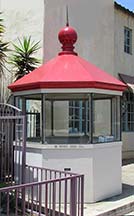
|
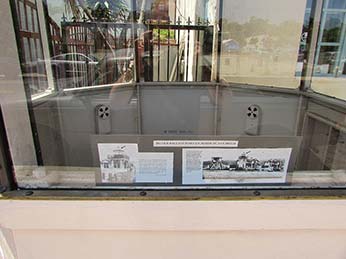
|
| LIGHTHOUSE BACK | DETAIL BRASS WINDOW MOLDINGS AND GLASS |
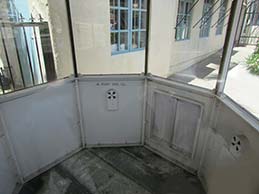 |
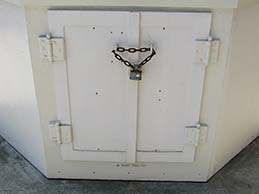
|
| INTERIOR | ENTRY DOORS. THERE WAS NO INTERNAL ACCESS TO THE LAMP ROOM |

|

|
| THE LIGHTHOUSE COMPLEX AS IT APPEARED IN THE 1940'S | DISMANTLING THE LANTERN ROOM IN 1960 |
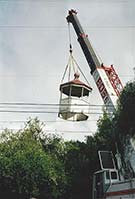
|
| LIGHTHOUSE GINGERLY BEING REMOVED OVER HIGH TENSION POWER LINES |


